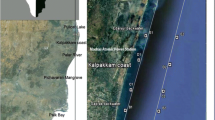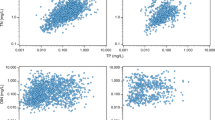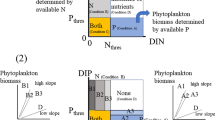Summary
Seasonal changes in nutrient concentrations, phytoplankton biomass and nutritional state were followed in two contrasting Antarctic lakes. Oligotrophic Sombre Lake receives little phosphate from its catchment and this limits the standing crop of phytoplankton which can develop in spring and summer. This situation appears to be typical of unenriched Maritime Antarctic lakes. Large numbers of seals and seabirds in the catchment of nearby Heywood Lake increase its phosphate loading and allow a much denser growth of phytoplankton. The N:P ratio is low and nitrogen rather than phosphate is the most limiting nutrient. Despite limitation of standing crop, photosynthetic rates in both lakes are relatively high and recycling of nutrients within the lake may be rapid.
Similar content being viewed by others
References
Allen SE, Grimshaw HM, Parkinson JA, Quarrnby C (1974) Chemical analysis of ecological materials. Blackwell, Oxford, pp 181–214
Burns NM, Ross C (1972) Oxygen-nutrient relationships within the central basin of Lake Erie. In: Allen HE, Kramer JR (eds) Nutrients in natural waters. Wiley Interscience, New York, pp 193–250
Chaney AL, Marbach EP (1962) Modified reagents for the determination of urea and ammonia. Clin Chem 8:130–132
Dillon PJ, Rigler FH (1974) The phosphorus-chlorophyll relationship in lakes. Limnol Oceanogr 19:767–773
Ellis-Evans JC (1981a) Freshwater microbiology in the Antarctic. 1. Microbial numbers and activity in oligotrophic Moss Lake. Bull Br Antarct Surv 54:8–104
Ellis-Evans JC (1981b) Freshwater microbiology in the Antarctic. 2. Microbial numbers and activity in mesotrophic Heywood Lake. Bull Br Antarct Surv 54:105–121
Ellis-Evans JC (1982) Seasonal microbial activity in Antarctic freshwater lake sediments. Polar Biol 1:129–140
Forsberg C, Ryding SO, Claesson A, Forsberg A (1978) Water chemical analysis and/or algal assay? Sewage effluent and polluted lake water studies. Mitt Int Ver Theor Angew Limnol 21:352–363
Goldman CR (1963) Primary productivity studies on Antarctic ponds and lakes. Polar Rec 11:503
Goldman JC, McCarthy JJ (1978) Steady state growth and ammonium uptake of a fast-growing marine diatom. Limnol Oceanogr 23:695–793
Golterman HL (1969) Methods for chemical analysis of fresh waters. IBP Handbook No 8 Blackwell, Oxford Edinburgh
Golterman HL (1975) Chemistry of running waters. In: Whitton BA (ed) River ecology. Blackwell, Oxford, pp 39–80
Hawes I (1983) Turbulent mixing and its consequences for phytoplankton development in two ice covered Antarctic Lakes. Bull Br Antarct Surv 60 (in press)
Healey FP (1979) Short term responses of nutrient deficient algae to nutrient addition. J Phycol 15:289–299
Heywood RB (1967) Ecology of the freshwater lakes of Signy Island, South Orkney Islands. I. Catchment areas, drainage systems and lake morphology. Bull Br Antarct Surv 14:25–43
Heywood RB (1968) Ecology of the freshwater lakes of Signy Island, South Orkney Islands. 2. Physical and chemical properties of the lakes. Bull Br Antarct Surv 18:11–44
Heywood RB (1978) Maritime Antarctic lakes. Verh Int Ver Limnol 20:1210–1215
Heywood RB, Dartnall HJG, Priddle J (1980) Characteristics and classification of the lakes of Signy Island, South Orkney Islands, Antarctica. Freshwater Biol 10:47–59
Ilmavirta V (1977) Diel periodicity in the phytoplankton community of the oligotrophic Lake Pääjärvi, Southern Finland. 3. The influence of the bottle material on the measurements of production. Ann Bot Fenn 14:102–111
Ilmavirta V (1982) Dynamics of phytoplankton in Finnish lakes. Hydrobiologia 86:11–20
Kalff J, Welch HE (1974) Phytoplankton production in Char Lake, a natural polar lake and in Meretta Lake, a polluted polar lake Cornwallis Island, Northwest Territories. J Fish Res Board Can 31:621–636
Laws EA, Bannister TT (1980) Nutrient and light limited growth of Thalassiosira fluviatilis in continuous cultures with implications for phytoplankton growth in the ocean. Limnol Oceanogr 25:457–473
Lean DRS, Pick FR (1981) Photosynthetic response of lake phytoplankton to nutrient enrichment. A test for nutrient limitation. Limnol Oceanogr 26:1001–1019
Light JJ, Ellis-Evans JC, Priddle J (1981) Phytoplankton ecology in an Antarctic lake. Freshwater Biol 11:11–26
Lund JWG, Jaworski GHM, Butterwick C (1975) Algal bioassay of water from Blelham Tarn, English Lake District and the growth of planktonic diatoms. Arch Hydrobiol (Suppl) 49:51–66
Morris I, Yentsch CM, Yentsch CS (1971) The physiological state with respect to nitrogen of phytoplankton from low nutrient sub-tropical water as measured by the effect of ammonium ion on dark carbon dioxide fixation. Limnol Oceanogr 16:859–868
O'Brien WJ (1972) Limiting factors in phytoplankton algae. Their meaning and measurement. Science 178:616–617
O'Brien WJ, Denoyelles F (1976) Response of three phytoplankton bioassay techniques in experimental ponds of known limiting nutrient. Hydrobiologia 49:65–76
Pechlaner R (1971) Factors that control the production rate and biomass of phytoplankton in high-mountain lakes. Mitt Int Ver Theor Angew Limnol 18:125–145
Priddle J, Heywood RB (1980) Evolution of Antarctic lakes ecosystems. Biol J Linn Soc 14:51–66
Rigler FH (1978) Limnology in the High Arctic: A case study of Char Lake. Verh Int Ver Limnol 20:127–140
Samsel GL, Parker BC (1972) Limnological investigations in the area of Anvers Island, Antarctica. Hydrobiologia 40:505–511
Schindler AW, Fee EJ (1973) Diurnal variation of dissolved inorganic carbon and its use in estimating primary production and CO2 invasion in Lake 227. J Fish Res Board Can 30:1501–1510
Schindler DW, Fee EJ, Ruszczynski T (1978) Phosphorus input and its consequences for phytoplankton standing crop and production in the Experimental Lakes Area, Canada and in similar lakes. J Fish Res Board Can 35:190–196
Senft WH (1978) Dependance of light-saturated rates of algal photosynthesis on intracellular concentrations of phosphorus. Limnol Oceanogr 23:709–718
Smith REH, Kalff J (1981) The effect of phosphorus limitation on algal growth rates: Evidence from alkaline phosphatases. Can J Fish Aquat Sci 38:1421–1427
Strickland JDH, Parsons RT (1972) A practical handbook of seawater analysis, 2nd edn. Bull Fish Res Board Can 167
Talling JF (1973) The application of some electrochemical methods to the measurement of photosynthesis and respiration in freshwater. Freshwater Biol 3:335–362
Talling JF (1976) The depletion of CO2 from lake water by phytoplankton. J Ecol 64:79–121
Tilzer MM (1973) Diurnal periodicity of the phytoplankton assemblage of a high mountain lake. Limnol Oceanogr 18:15–30
Vincent WF (1981) Production strategies in Antarctic inland waters: Phytoplankton ecophysiology in a permanently ice-covered lake. Ecology 62:1215–1224
Vollenweider RA (1969) A manual on methods for measuring primary production in aquatic environments. IBP Handbook No 12. Blackwell, Oxford
Wood ED, Armstrong FAJ, Richards FA (1967) Determination of nitrate in sea-water by cadmium-copper reduction to nitrite. J Mar Biol Assoc UK 47:23–31
Yull Rhee G (1978) Effects of N:P atomic ratios and nitrate limitation on algal growth, cell composition and nitrate uptake. Limnol Oceanogr 23:10–25
Author information
Authors and Affiliations
Rights and permissions
About this article
Cite this article
Hawes, I. Nutrients and their effects on phytoplankton populations in lakes on Signy Island, Antarctica. Polar Biol 2, 115–126 (1983). https://doi.org/10.1007/BF00303177
Received:
Accepted:
Issue Date:
DOI: https://doi.org/10.1007/BF00303177




